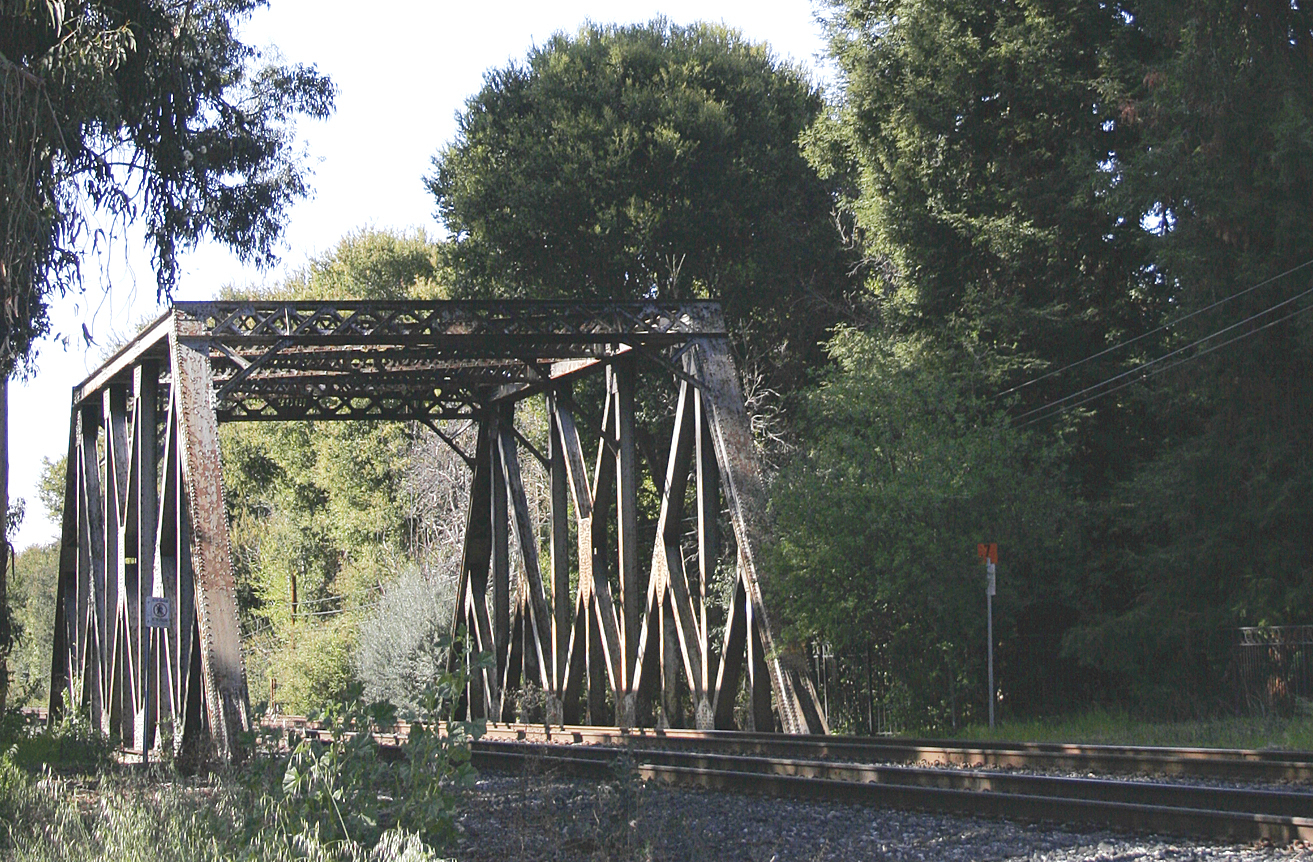For more than a century, the San Francisquito Bridge has supported freight and passenger trains crossing the border between Palo Alto and Menlo Park.
Located just north of the Palo Alto Avenue rail crossing, the 104-foot steel-truss span stands at a uniquely sensitive spot, close to both the San Francisquito Creek and the city's iconic namesake redwood, El Palo Alto. But while it continues to hold up reasonably well, Caltrain has determined that it is nearing the end of its lifespan. Last week, the agency informed city officials that it is planning to begin work on replacing the bridge in about two years.
For Palo Alto, the replacement would have significant ramifications. Once construction begins, Caltrain would have to close off the area to train traffic and bus Caltrain passengers between the Palo Alto and Menlo Park stations. The project may also upend the city's ambitious plans to redesign its rail corridor so that roads and tracks would no longer intersect. It would be harder for Palo Alto to make a case for raising or lowering the railroad tracks as part of a new grade-separation design once a new bridge is built at grade, as it is currently.
Robert Barnard, Caltrain's deputy director of rail development, told the Palo Alto City Council's Rail Committee that recent inspections of the 1902 structure showed that the bridge is weakening in some areas and convinced the agency to consider replacement.
"We found that for a bridge of its age, the members are of good shape, and have minimal deterioration. That is good. However, the strength testing found that the material was weaker than we expected," Barnard said.
Caltrain is taking some immediate steps to ensure that the bridge will remain safe. When a freight train is on the bridge, no other trains are allowed to pass on adjacent tracks. Inspections are more frequent, taking place every six months instead of annually. And Caltrain is installing a monitoring system to identify any cracks that may form on the bridge between the inspection periods. Ultimately, however, the bridge will need to be replaced, Barnard said.
"The bridge is 120 years old. It is nearing the end of its service life," Barnard said during the Sept. 21 discussion.
The agency is feeling some time pressure in advancing the project. Once it fully implements the electrification of the rail corridor in 2024, train frequency will increase from its current level of one train every 15 minutes during peak commute times to one every 10 minutes. It will further increase to one train every 7.5 minutes by 2029 and then to one every six minutes in 2033, Barnard said.
"The longer we wait, the older the bridge gets. The longer we wait, ridership is forecasted, we hope, to increase. And with these considerations, the bridge really needs to be replaced by 2033," Barnard said.
Caltrain is set to spend the next two years planning for the project so that it can select a preferred alternative in 2025 and proceed with environmental analysis and permitting. The agency hopes to procure contractors in 2031 and build the bridge over the following two years.
The plan, however, throws a wrench into Palo Alto's plans for grade separation at its four rail crossings. In recent years, the council has focused almost exclusively on the Churchill Avenue crossing, where it is evaluating an underpass for cars, and on Charleston Road and Meadow Drive in the southern end of the city. Plans for the northernmost crossing, Palo Alto Avenue, have been deferred indefinitely after council members decided in 2018 that they would prefer to evaluate it as part of a planning effort for the broader downtown area, which includes the University Avenue transit station. That effort has yet to kick off.
Caltrain's plans for the San Francisquito Bridge may accelerate the city's planning for Palo Alto Avenue. Rail Committee members acknowledged after the presentation that they may need to reconsider their priorities.
"I think there will be a real question for our community over the next two years," Council member Alison Cormack said. "Are we going to use this time to focus on this particular grade separation, which to date, we really have not for a variety of other reasons and take advantage of what I would call a medium-sized window of opportunity?"
Mayor Pat Burt urged Caltrain officials to consider strengthening the bridge rather than replacing it. To date, Caltrain has been reluctant to spend time and money to reinforce a bridge that the agency believes will need to be eventually replaced anyway.
"You're spending capital money on a Band-Aid and then you're spending money again to replace the asset, and the total cost increases as opposed to doing the capital replacement one time," Barnard said.
Palo Alto officials noted, however, that the bridge-replacement project could significantly influence the city's actions on the intermodal transit center, which includes the downtown Caltrain station and supports a wide array of bus services. The existing car underpass at University Avenue is old, Burt said, and may require its own redesign or reconstruction. He urged Caltrain to reconsider its decision to replace the bridge in light of the broader downtown context.
"There's a downside to spending money to reinforce the existing bridge, but you add this project together and it's potentially massive," Burt said. "And coming up with a real cohesive plan for that within the next few years is going to be a real stretch if not an impossibility."
Vice Mayor Lydia Kou also emphasized the historic significance of the bridge location, particularly given its proximity to El Palo Alto.
"A lot of outreach to the community is going to be needed so that they understand that it's not going away or going to be hurt or damaged in any way," Kou said.



Comments